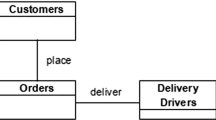Abstract
Conceptual modeling is often viewed as an activity of representing a preexisting world that should be faithfully mirrored in an information system. This view is adequate for modeling physical domains but needs to be revised and extended for social and institutional domains, as these are continuously produced and reproduced through communicative processes. Thereby, conceptual modeling moves beyond analysis and representation in order to cater also for design and creation. Following such a view on conceptual modeling, this paper proposes an ontology for modeling institutional domains. The ontology emphasizes the role of institutional entities in regulating and governing these domains through rules and rights that define allowed and required interactions. Furthermore, the ontology shows how these institutional entities are dependent on and grounded in material entities. Conceptual modelers can benefit from the ontology when modeling institutional domains, as it highlights fundamental notions and distinctions in these domains, e.g., the role of rights, the role of processes in creating institutional facts, and the difference between documents and institutional information. The ontology is illustrated using a case on public consultation management.
Access this chapter
Tax calculation will be finalised at checkout
Purchases are for personal use only
Preview
Unable to display preview. Download preview PDF.
Similar content being viewed by others
References
van der Aalst, W.M.P.: Business process management: A comprehensive survey. ISRN Software Engineering 2013, 1–37 (2013)
Bergholtz, M., Eriksson, O.: Towards a Socio-Institutional ontology for conceptual modelling of information systems. In: Advances in Conceptual Modeling. pp. 225–235. Springer, Cham (19 Oct 2015)
Bergholtz, M., Eriksson, O., Johannesson, P.: Towards a sociomaterial ontology. In: Advanced Information Systems Engineering Workshops. pp. 341–348. Springer, Berlin, Heidelberg (17 Jun 2013)
Catt, H., Murphy, M.: What voice for the people? categorising methods of public consultation. Aust. J. Polit. Sci. 38(3), 407–421 (1 Nov 2003)
Dietz, J.L.G.: Enterprise Ontology: Theory and Methodology. Springer (2006)
Dumas, M., La Rosa, M., Mendling, J., Reijers, H.A.: Fundamentals of Business Process Management:. Springer Berlin Heidelberg (2013)
Eriksson, O., Henderson-Sellers, B., Ågerfalk, P.J.: Ontological and linguistic metamodelling revisited: A language use approach. Information and Software Technology 55(12), 2099–2124 (Dec 2013)
Geerts, G.L., McCarthy, W.E.: Policy-level specifications in REA enterprise information systems. Journal of Information Systems 20(2), 37–63 (2006)
Graeber, D.: The utopia of rules: On technology, stupidity, and the secret joys of bureaucracy. Melville House (2015)
Gruber, T.R.: Toward principles for the design of ontologies used for knowledge sharing? Int. J. Hum. Comput. Stud. 43(5), 907–928 (1 Nov 1995)
Hodgson, G.M.: What are institutions? J. Econ. Issues 40(1), 1–24 (2006)
Hohfeld, W.N.: Some fundamental legal conceptions as applied in judicial reasoning. Yale Law J. 23(1), 16–59 (1913)
Hruby, P.: Model-Driven Design Using Business Patterns. Springer, Berlin; London, softcover reprint of hardcover 1st ed. 2006 edition edn. (9 Nov 2010)
Masolo, C.: Levels for conceptual modeling. In: De Troyer, O., Bauzer Medeiros, C., Billen, R., Hallot, P., Simitsis, A., Van Mingroot, H. (eds.) Advances in Conceptual Modeling. Recent Developments and New Directions, Lecture Notes in Computer Science, vol. 6999, pp. 173–182. Springer Berlin / Heidelberg (2011)
McCarthy, W.E.: The REA accounting model: A generalized framework for accounting systems in a shared data environment. The Accounting Review 57(3), 554–578 (1982)
Nardi, J.C., Falbo, R.d.A., Almeida, J.P.A., Guizzardi, G., Pires, L.F., van Sinderen, M.J., Guarino, N., Fonseca, C.M.: A commitment-based reference ontology for services. Inf. Syst. 54, 263–288 (Dec 2015)
Olivé, A.: Conceptual Modeling of Information Systems. Springer Berlin Heidelberg (2007)
Parsons, J., Li, X.: An ontological metamodel of classifiers and its application to conceptual modelling and database design. In: Conceptual Modeling - ER 2007. pp. 214–228. Springer, Berlin, Heidelberg (5 Nov 2007)
Patton, M.Q.: Qualitative evaluation and research methods, 2nd ed. Sage Publications, Inc (1990)
Rodrigo, D., Amo, P.A.: Background document on public consultations. Tech. rep., OECD (2012)
SBVR: SBVR 1.4. http://www.omg.org/spec/SBVR/1.4/index.htm, accessed: 2017-5-18
Searle, J.: Making the Social World: The Structure of Human Civilization. Oxford University Press, USA, 1 edn. (12 Jan 2010)
Searle, J.R.: The Construction of Social Reality. Free Press (1 Jan 1997)
Searle, J.R.: Social ontology: Some basic principles. Anthropological Theory 6(1), 12–29 (1 Mar 2006)
Steimann, F.: On the representation of roles in object-oriented and conceptual modelling. Data Knowl. Eng. 35(1), 83–106 (Oct 2000)
Wand, Y., Storey, V.C., Weber, R.: An ontological analysis of the relationship construct in conceptual modeling. ACM Trans. Database Syst. 24(4), 494–528 (Dec 1999)
Wand, Y.,Weber, R.: On ontological foundations of conceptual modeling: A response toWyssusek. Scandinavian Journal of Information Systems 18(1) (2006)
Author information
Authors and Affiliations
Corresponding author
Editor information
Editors and Affiliations
Rights and permissions
Copyright information
© 2017 Springer International Publishing AG
About this chapter
Cite this chapter
Johannesson, P., Bergholtz, M., Eriksson, O. (2017). CreatingWorlds with Words: Ontology-guided Conceptual Modeling for Institutional Domains. In: Cabot, J., Gómez, C., Pastor, O., Sancho, M., Teniente, E. (eds) Conceptual Modeling Perspectives. Springer, Cham. https://doi.org/10.1007/978-3-319-67271-7_12
Download citation
DOI: https://doi.org/10.1007/978-3-319-67271-7_12
Published:
Publisher Name: Springer, Cham
Print ISBN: 978-3-319-67270-0
Online ISBN: 978-3-319-67271-7
eBook Packages: Computer ScienceComputer Science (R0)




